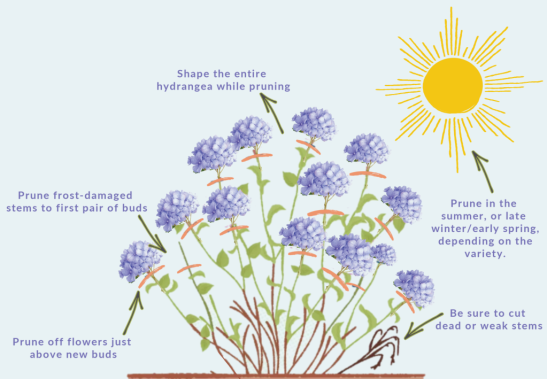Pruning Trees + Shrubs Series: Hydrangeas
As Fall turns to Winter our trees and shrubs become dormant and we naturally think “it’s time to prune”. CAUTION! You are entering a DANGER ZONE! Pruning improperly can destroy what nature has taken years to create. Cutting dead looking stems off shrubs can eliminate all flowers the following year. Pruning the wrong branches from trees can negatively affect their structure, overall beauty and decrease fruit production. Ask questions, do a bit of research before grabbing the clippers or pruning saw.
This is the first of several articles offering “easy to follow” suggestions on pruning popular shrubs and trees. Following these instructions will reward you with healthy, blooming trees and shrubs for years to come.
Let’s talk Hydrangeas.
These beautiful shrubs brighten up the shady spots in our yards with multiple blooms on each plant during the spring, summer and into fall. But if pruned incorrectly they will flower very little or not at all.
First step is to identify what type of Hydrangea you have. Most hydrangea varieties bloom on last year’s growth – stems or branches that grew this year, will bear flowers next year. This is common for mophead, lacecap and oakleaf hydrangeas.
– Mopheads are known for their round balls of either white, pink or blue blooms.
– Lacecaps are a flatter, multi-blooming flower resembling flat caps with frilly edges.
– Oakleaf are recognized by their distinctive leaves shaped like those of an oak tree.
These 3 types should be pruned after blooming (late summer/early fall). These bloom for several months so you may need to selectively prune shoots that have already bloomed while leaving others to finish blooming through the season.
If you prune these types of hydrangeas back to the ground in winter, you will not have flowers the following year.

Reblooming Varieties: If your hydrangea is one of the newer reblooming varieties (Endless Summer series, Forever & Ever series) they bloom on both current season’s growth as well as previous years branches. These varieties should not be cut to the ground either – this will delay blooms.
How to Prune
1. Start by removing dead or damaged stems first.
2. If the plant is too large, cut the oldest shoots to the ground, giving the younger, smaller shoots more room to grow. This will shorten and thin out the plant.
3. Cut back stems to just above a pair of healthy buds.
4. Varieties that bloom on old wood should be pruned immediately after they flower
Tip: We suggest planting hydrangeas with non-deciduous shrubs in your landscape. This will allow the focus to shift from the hydrangeas to these other shrubs during the winter months.
By pruning at the correct time of year and using the correct pruning methods your Hydrangeas should reward you with a bounty of colorful blooms from spring through early fall.


